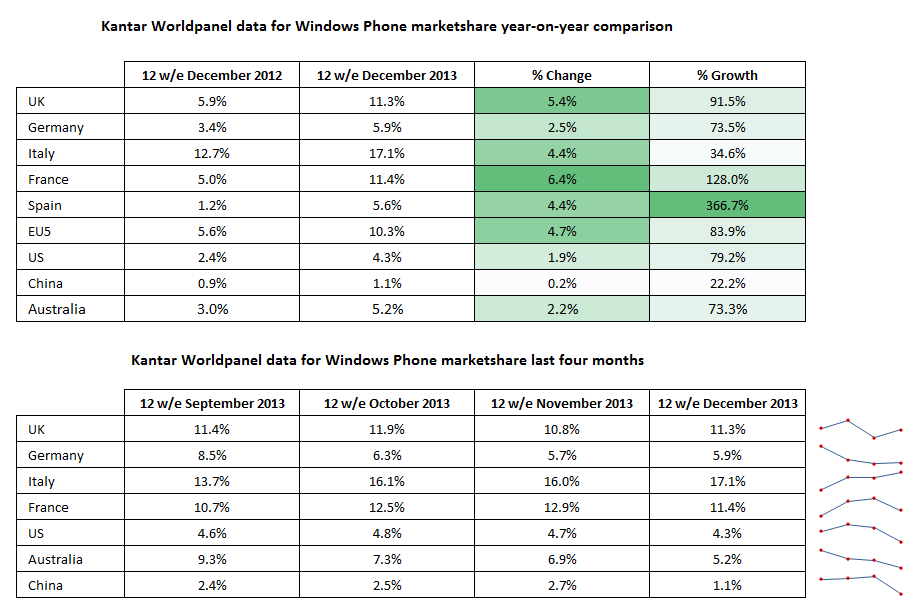The main data point is the latest Kantar Worldpanel data, already covered here by Rafe, showing Windows Phone's steady market share in excess of 10% in the 'Big Five' European countries of Germany, the United Kingdom, France, Italy, and Spain, over the last six months:

While statistics can be spun around and read in many ways, by looking at the trend of data over a longer time base you get a better feel of what those numbers are doing. In the case of EU5 market share, the progress is upwards. It's not a steep trend, but it is going in the right direction.
Given the relatively weak news portfolio coming out of Mobile World Congress, Microsoft standing up and saying 'we are third' rather than 'we will be third' has been pushed down the digital front pages of the world in favour of new sexy devices (the Android powered Sony Xperia Z2), the new flagships (the Android powered Samsung Galaxy S5), the curious (the dual screened Android powered Yota Phone 2), and the 'what are they thinking?' products (including the Android powered Nokia X family). But it's still an important change of their position.
Microsoft's lack of news for MWC and CES should not be something they are proud of. Redmond is not in a position to 'break the rules' of the game because Microsoft is perceived to be in a weak position in the smartphone market. Conversely, having the '10%' news is something that would increase the positive perception of Microsoft's mobile ambitions.
I've written before on All About Windows Phone about the importance of the 10% level (and how important it is that the US market hauls itself up to the same level as quickly as possible so that the marketing messages can be aligned and focus on a 'mass market' approach), but the 10% marker also allows Microsoft to start pushing a different style of presentation in the media - the stories that can only be told by an incumbent player.
I'm sure that many of those stories will be told [Ewan, you really should work in PR you know! - Ed] during April's 'Build' Conference, where the next version of both Windows 8 and Windows Phone 8 will not only be revealed, but more than likely be demonstrated on brand new hardware.
While that 10% mark hasn't been reached around the world (notably in North America), you can expect Windows Phone 8.1 to be positioned not as an upstart challenger, but as an established and significant player in the mobile space. Yes, the numbers are nowhere near as high as Android or iOS, but Windows Phone is the third platform. Blackberry is slipping away, and while there are a number of smaller companies building up their own mobile OS platforms (Jolla's Sailfish, Firefox OS, and Ubuntu's mobile version of their Linux distro), Windows Phone is 'last man standing' and that ten percent gives Microsoft a legitimate seat at the top table.

There are a number of indications at MWC on the medium and long-term plans. Microsoft has expanded the hardware partners working with the platform (joining the existing WP8 partners Nokia, Samsung, HTC and Huawei, you can add Foxconn, Gionee, Lava/Bolo, Lenovo, LG, Longcheer, JSR, Karbonn and ZTE); the hardware requirements have been loosened; and reference designs are in place for smartphones built around the lower cost Snapdragon 200 and 400 series architecture.
That represents a nice mix of established Windows Phone players in the Western market, a new entrant to the smartphone world (in Lenovo, who of course are the new owners of Motorola), and the Chinese players looking to grow the smartphone pool with tens of millions of new users.
While the future path has not quite been laid out, Microsoft's actions around MWC have given us a few pointers as to its future direction. Now we just need to wait as the facts unspool themselves over the next few months and see if the analysts and the financial markets agree with the strategy.
